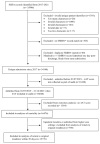Delirium on presentation with a hip fracture is associated with adverse outcomes : a multicentre observational study of 18,040 patients using national clinical registry data
- PMID: 40164178
- PMCID: PMC7617671
- DOI: 10.1302/0301-620X.107B4.BJJ-2024-1164.R1
Delirium on presentation with a hip fracture is associated with adverse outcomes : a multicentre observational study of 18,040 patients using national clinical registry data
Abstract
Aims: Delirium is common in hip fracture patients, but large-scale routine data studies examining the prevalence and associations of delirium at the time of initial presentation with a hip fracture are rare. This study aimed to describe the prevalence and outcomes of delirium on initial presentation with a hip fracture in a large national population sample.
Methods: This study analyzed routinely collected national clinical registry data for all people in Scotland aged 50 years and over presenting with a hip fracture between 1 July 2019 and 31 December 2021. Delirium was assessed prospectively by clinicians as part of routine care using the 4AT, a validated two-minute assessment tool. Associations of 4AT score with mortality and return home within 30 days were analyzed using logistic regression models, adjusted for confounders.
Results: Of 18,040 patients (mean age 80 years (SD 10); 70% female (n = 12,594)), 16,476 (91%) had a 4AT assessment on presentation and of these, 3,386 (21%) had a score ≥ 4, suggestive of delirium. Patients with delirium were older, more likely residing in care homes, and had higher American Society of Anesthesiologists grades (all p < 0.001). Delirium was independently associated with a twofold increased risk of inpatient mortality (adjusted odds ratio (aOR) 2.26 (95% CI 1.79 to 2.84)) and one-year mortality (aOR 2.05 (95% CI 1.83 to 2.29)), and a lower likelihood of returning home within 30 days (aOR 0.27 (95% CI 0.24 to 0.30)).
Conclusion: Delirium affects around 20% of patients presenting with a hip fracture, and is associated with important adverse outcomes. Integrating delirium assessment into the initial clinical assessment of hip fracture patients is feasible at national scale, and should be considered as part of care for all hip fracture patients.
© 2025 The British Editorial Society of Bone & Joint Surgery.
Conflict of interest statement
R. S. Penfold is a fellow on the Multimorbidity Doctoral Training Programme for Health Professionals, which is supported by the Wellcome Trust (223499/Z/21/Z). L. Farrow is currently in receipt of a Clinical Academic Fellowship from the Chief Scientist Office that is unrelated to the submitted work. A. Johansen is clinical lead for the National Hip Fracture Database (NHFD), RCP London. D. E. Hall reports an institutional grant (paid to University of Pittsburgh Medical Center) from the Office of Research and Development, Veterans Health Administration, Department of Veterans Affairs, United States Government, related to this study. A. M. J. MacLullich is the main author of the 4AT assessment tool; there is no financial conflict of interest.
Figures
References
-
- Yan E, Veitch M, Saripella A, et al. Association between postoperative delirium and adverse outcomes in older surgical patients: A systematic review and meta-analysis. J Clin Anesth. 2023;90:111221. - PubMed
-
- Penfold RS, Hall AJ, Anand A, et al. Delirium in hip fracture patients admitted from home during the COVID-19 pandemic is associated with higher mortality, longer total length of stay, need for post-acute inpatient rehabilitation, and readmission to acute services. Bone Jt Open. 2023;4(6):447–56. doi: 10.1302/2633-1462.46.BJO-2023-0045.R1. - DOI - PMC - PubMed
-
- Lisk R, Yeong K, Enwere P, et al. Associations of 4AT with mobility, length of stay and mortality in hospital and discharge destination among patients admitted with hip fractures. Age Ageing. 2020;49(3):411–7. - PubMed
-
- Williams ST, Dhesi JK, Partridge JSL. Distress in delirium: causes, assessment and management. European Geriatric Medicine. 2020;11(1):63–70. - PubMed


